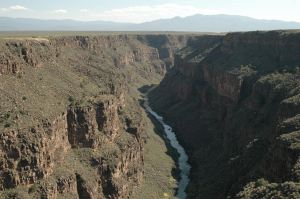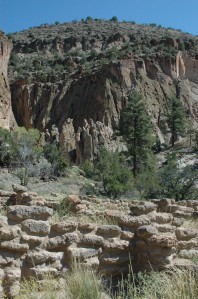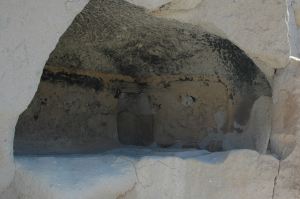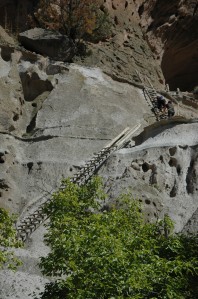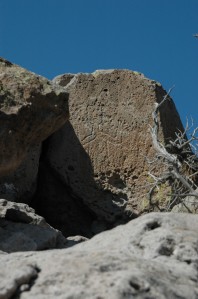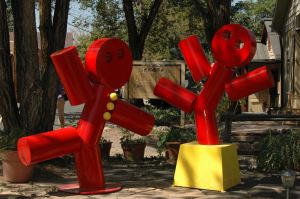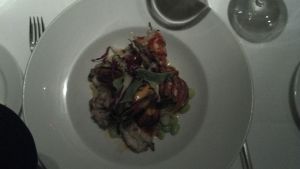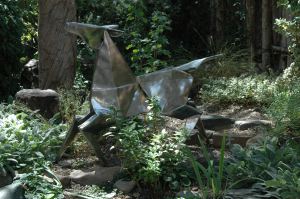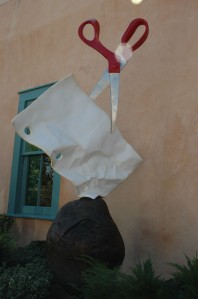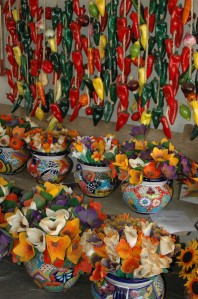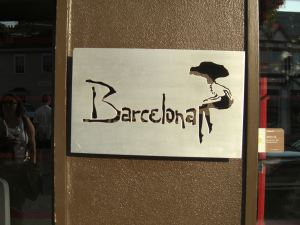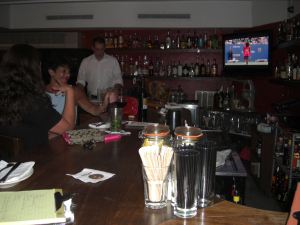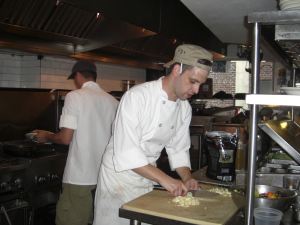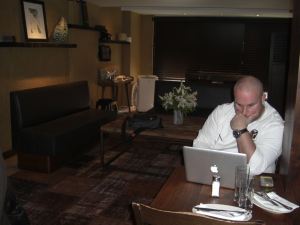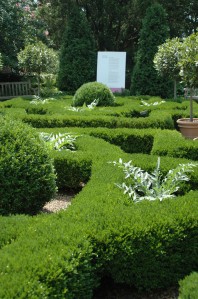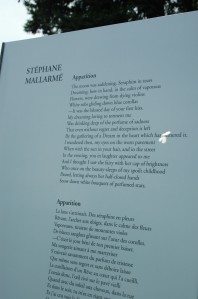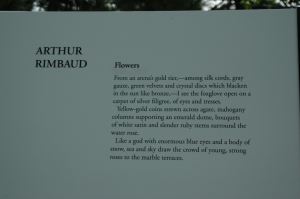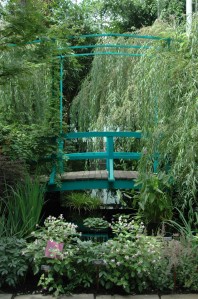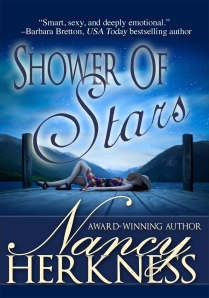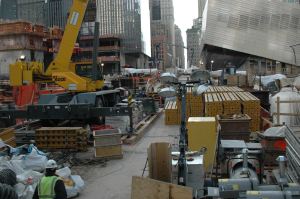Blog
Westward ho! to New Mexico (Part 2)
Exploring outside Santa Fe is fabulous too. We headed north to Taos where, much to our disappointment, the Taos Pueblo was closed for undisclosed reasons. However, I was delighted to discover that the fifth highest vehicular bridge in the U.S. is nearby. You all know I have a bridge phobia (I can’t drive a car across one), yet I am fascinated by them. So the Rio Grande Gorge Bridge was a must-see for me.
I can’t drive across it but I walked all the way over and back. Here’s the view looking down 650 feet. Spectacular!
We visited Kit Carson’s house where I got artsy with my photo in the courtyard. Did you know his first wife was an Arapaho woman (who died) and his second a beautiful fourteen-year-old named Josefa Jaramillo? As well as having eight children, he and Josefa adopted several Indian children. An interesting man.
The scenery is stunning. This is a random view on the road to Taos.
My favorite place though was Bandelier National Monument with its cliff dwellings and petroglyphs. We hiked through Frijoles Canyon where the Ancestral Pueblo people settled. (They used to be called Anasazi, a much more musical name, but it turns out the Navajo Indians labeled them that because it meant “ancient enemies”.)
About 100 of the Pueblo people lived here, some on the floor of the canyon where these walls are.
Some lived in “cavates”, carved from the soft volcanic tuff of the cliffs, like this one. The black on the ceiling is from their fires.
One dwelling, called the Alcove, requires climbing 140 feet of ladders, which I am proud to say I did. It doesn’t sound so hard until you remember that it’s at about 6,000 feet of altitude and I live at sea level in New Jersey. There’s a lot less oxygen than I’m used to in the air there. This is a shot looking up a couple of the ladders.
It was worth the trip to see this reconstructed kiva, a chamber dug into the soft rock of the cliff which is believed to have been used for religious reasons. I climbed down inside it and could almost feel the presence of ancient spirits.
I’m intrigued by petroglyphs so our next destination was Tsankawi, a nearby site with lots of the enigmatic rock carvings. The hike itself was challenging because the volcanic stone is so soft there that years of footsteps have worn the path to a deep, narrow groove. The picture below is one of the more passable sections.
It was well worth the struggle though when I encountered these fellows. It looks like one is playing a flute of some sort, I think.
And there was this guy with the unusual head gear:
These petroglyphs sort of brought me full circle back to the contemporary art on Canyon Road in Santa Fe. The happy fellows below seem to come out of the tradition of the rock carvings, don’t you think?
Westward ho! to Santa Fe (Part 1)
Handsome Husband and I kept hearing about how fabulous Santa Fe is so we decided our “empty nest” trip (the one we take to cheer ourselves up after the children disappear off to college in the fall) should be to New Mexico.
It was a little scary at first because we had to drive through a dust storm on our way from Albuquerque to Santa Fe. I felt like I was in the Sahara Desert…
When we told our innkeeper about the phenomenon, even he was taken aback. Evidently, dust storms aren’t all the common, even in New Mexico. Our inn was spectacular, an Arabian nights fantasy. There’s just one of the courtyards:
And here are the sinks in our bathroom. I wanted to bring the entire bathroom home with me and plunk it down in my Victorian house (where it would have looked like a peacock in a hen house but who cares!).
Santa Fe is old (well, for a place in the United States). My children and I have a running joke about the second oldest church in the New World because I always drag them to places like that. So I texted them photos of 1) the oldest church in the U.S., the San Miguel Mission:
And 2) the oldest house in the U.S., made of adobe, of course, because most everything in Santa Fe is made of a adobe or an imitation thereof. It’s very lovely and warm.
I also shared 3) the oldest government building in the U.S. and 4) the oldest bar in Santa Fe with the kidlets, but I won’t inflict them on you.
Santa Fe has great restaurants which we sampled with gusto, including this fabulous lobster dish at Geronimo on Canyon Road. It combined mesquite-grilled lobster and chili sauce, along with delicious Lima beans and other goodies, truly New Mexican cuisine.
I also discovered the deliciousness of dark chocolate with chilis embedded in it. Yum!
Canyon Road is also famous for its concentration of art galleries. The sculptures ranged from weird to beautiful to whimsical. Some of my favorites:
They love horses in Santa Fe!
An artist with an inner child!
Not sure what this one says to me…
You didn’t have to stroll the expensive galleries of Canyon Road to find visual pleasures though. I found this just strolling down a random street in town. Ah, the colors of the southwest!
Stay tuned for Part 2, wherein we venture outside of Santa Fe.
I love my job!
Why is it great to be a writer? There are so many reasons—no commute, no pantyhose—but one major one is the cool stuff I get to do in the name of research. This time it involved food which is always a good thing, in my opinion.
The hero of Book 3 in my Sanctuary series is a chef, a career I know virtually nothing about. Luckily, my critique partner Miriam Allenson has a son in the restaurant business, and she volunteered him as a resource. We writers are quite ruthless in using our friends’ connections for this sort of thing so I immediately accepted her offer.
My research trip turned out better than I ever expected. Miriam’s son works at Barcelona, a fabulous tapas bar and restaurant in Greenwich, CT. He invited us to come see what goes on in the kitchen and talk to the executive chef Adam Greenberg as he worked.
Did I mention that we got treated like royalty? It pays to be with the mother of the restaurant’s well-respected general manager. First stop: the elegant bar, where we were plied with superb sangria and given a glimpse into the life of a bartender by Brandon.
We also sampled pata negra, a cured ham made from free-range pigs that forage on the border between Spain and Portgual and eat nothing but acorns. It is bacon taken to the highest level of scrumptiousness.
We were then seated at the chef’s table, a high marble counter with a great view of the kitchen’s smoothly-oiled workings. I tried really, really hard to keep my mind on business: asking probing questions, taking pages of notes, and snapping photos.
But the chefs kept sliding plates of scrumptious tapas in front of us, describing them in mouth-watering terms that built the anticipation, and then leaving us to sample and savor each delicious bite. It was hard to concentrate on my true mission when I was experiencing the exquisite flavors of chorizo and figs, flank steak with black truffle oil, locally grown roasted peppers, warm crusty bread and jamon sliced paper-thin on a beautiful antique meat slicer. I’m drooling on my keyboard as I relive it.
By the time they offered us a choice of desserts, I was so full I couldn’t eat another bite. Yet when Chef James put his special tart of baked apples topped with crunchy oatmeal and cinnamon ice cream in front of me, somehow I managed to force a few spoonfuls down. Unbelievably delicious! Then they brought us dulce de leche crepes drizzled with chocolate. Again I swore not another bite would fit, but I ate several. Divine!
Oh right, what did I learn about being a chef? That it requires a high level of organization and an ability to train and supervise a staff that has to work together night after night under pressure without killing each other. A passion for food is a given, but so is a passion for making your patrons happy. If a customer asks for a special dish, Chef Adam says someone will race out and buy the ingredients if necessary. An executive chef has to be an accountant and an artiste all in one person since he is responsible for the budget and for creating new dishes that won’t break it.
Here’s Chef Greenberg studying spreadsheets before the dinner rush begins:
There’s so much more in my pages and pages of notes, some of which will appear in detail in the book and some of which will simply paint a vivid background in my mind so I can give my hero depth and authenticity.
In the meantime, I ate like a queen!
A big thank you to the folks at Barcelona Greenwich for sharing your joy in your work with me!
Monet’s Garden for the poet
The gardens outside the Monet’s Garden exhibit are just as beautiful as the indoor ones, even though they are not modeled on the artist’s vision. The New York Botanical Garden very cleverly lured visitors out into the heat by scattering large placards bearing French Symbolist poetry around the gardens near the conservatory, tying them into Monet’s milieu.
The poems by Baudelaire, in particular, brought back my angsty teenaged years when I thought Les Fleurs du Mal (The Flowers of Evil) was the most sophisticated poetry in the world. I even attempted to read Baudelaire in French in those days, not very successfully.
While I’m not nearly as attracted by the scent of sex and death those poets exude, there is some lovely imagery which I could not resist posting here.
I love that last line: Snow down white bouquets of perfumed stars. Is that not exactly what the petals dropping off a white lilac look and smell like? Gorgeous!
And Rimbaud’s elegant and vivid “carpet of silver filigree, of eyes and tresses.” My friend Betsy, a rose lover, has decided she needs to add marble terraces to her garden, based on this poem.
And now a blast from my past. For those who have read my biography, you know that I wrote poetry in college. One day I took a break from studying to wander through the Princeton University Art Museum. They had–and still have, as far as I know–on exhibit there a particularly beautiful rendering by Monet of his Japanese bridge with waterlilies. I became entranced by it and wrote a poem in its honor. No one has seen this poem in years but I am going to allow you, my faithful readers, the signal honor of reading it here.
Here is the Botanical Garden’s recreation of the bridge, just to put you in the mood:
And here is my poem, written long ago. Be kind. I was very young.
Monet’s “Waterlilies”
I have been there so many times;
Walked to the center of the bridge,
The highest point in the arch,
Stared down at the fish
Barely flickering through the stream,
Admired myself and the waterlilies
In the water-mirror
By the slim, cutting willows.
But I could never show you those things
So you could hang them on the wall
And walk back into them.
I could never change the green
From sun to shade
So you could feel it on your arms.
Monet’s greatest work of art…his garden
Alas, I did not journey to France to visit Giverny. No, I visited the exhibit of Monet’s Garden at the New York Botanical Garden in the Bronx.
My friend Betsy and I decided we needed to take another one of our adventures, and this appealed to us. We began in the conservatory with this delightful reflected photograph of Monet’s famous waterlilies.
We progressed from there outdoors to visit the real thing.
The water garden was not part of the original property Monet purchased near Giverny. In fact, it lies across a set of railroad tracks. His plan to create the lily pond caused great consternation among his neighbors who feared his exotic plants would poison their water supply. He placated them by paying to have the local road paved (which also cut down on the dust drifting onto his plants). Neighbors haven’t changed much, have they?
Here’s a closeup of one of the fabulous flowers Monet captured so gorgeously in his paintings:
Next we found a recreation of the famous Japanese bridge, blessedly back indoors since the day had become quite hot.
We progressed past the bridge (after walking across it, of course. Who could resist?) to the Grande Allée recreated to match the brilliant colors and unstructured beds of Monet’s Giverny.
I’ve grafted two photos together to give you a sense of what it’s like to walk through the arches. The colors are glorious, with juxtapositions a non-artist would never attempt, like the one below.
The exhibit includes wonderful photographs from both the artist’s time and today, as well as letters Monet wrote about creating the garden (including his problems with the difficult neighbors). Two of his paintings are on display (also blissfully air-conditioned). However, despite his fame and success as a prolific painter (2,500 paintings!), here is what Monet had to say about his art:
Finding an agent or editor: the submission process
One of my blog readers asked me to go back a step from my previous blog, and talk about how to find an agent or editor. I responded in the comments, but thought perhaps I should post it as a separate blog entry so more interested parties might read it. Below is a quick overview of what’s required to submit your masterpiece to an agent or editor.
1) Finish the book. Revise it. Proofread it. Polish it to diamond brilliance with not a typo in sight. It’s a highly competitive market out there, and your book needs to stand out as professional.
2) Do a lot of research. Publishers Marketplace is a wonderful resource (for $20/month) where you can look up what agent/editor has bought what book (genre, etc.) both recently and historically. Find the ones who have bought your kind of book and make a long list of names, email addys, etc. There is NO point in querying an agent/editor who doesn’t represent/acquire the kind of book you’ve written.
Attending writers’ conferences is a great way to get a feel for acquiring editors and agents. They often participate in panels you can attend, and you might even be lucky enough to sit beside one at a meal or in the bar. Do NOT hand them your manuscript at the conference! Ask for a business card, and email your submission to them afterward. Editors tell horror stories of writers tracking them down in the rest room and sliding manuscripts under the stall door. This will not endear you to the person you want to read your book.
3) Check the agents’ websites for what they want you to submit. Ditto the publishers. Note: it is very hard to get your manuscript read by a publisher at one of the big New York houses without having an agent.
4) Write a professional, businesslike query letter which has at least one paragraph tailored to the person you are querying. Otherwise they will know you didn’t do your homework and reject your book before they even read your partial.
5) Submit in the fashion the agent/editor requests, always including a query letter. By this I mean, if the agent/editor wants a two-page synopsis and fifteen pages of your manuscript, that’s what you send. If they want a ten-page synopsis and fifty pages of your manuscript, send that. Many will not accept attachments, so don’t send those if they tell you not to. Read the instructions carefully, and follow them! Don’t give the agent/editor an easy excuse to reject your submission.
The only deviation from these rules that I allow myself is this: At the bottom of my query email, below my signature, I will paste in the first three or so pages of my manuscript. I do this because several agents and editors have unofficially stated they will read that to get a taste of your writing style. Also, it’s more interesting than reading nothing but query letters all day long.
6) If you are fortunate enough to get a rejection with specific suggestions for improving your work, consider revising with those in mind.
7) Submit often and simultaneously. As soon as you get a rejection, submit to someone else.
8) If you give up after one or two or even a dozen rejections, you’re probably not going to get published. This business requires tremendous persistence.
9) OTOH, you always have the option of self-publishing, a wonderful new avenue for writers. Many multi-published authors self-publish at least some of their books.
I wish you the best of luck in your quest!
How does a book get published? A step-by-step description
Several people have asked me what’s going on with my upcoming book Take Me Home (being released November 6th, for those who didn’t hear my original shouts of joy). So I thought I’d explain the steps it takes for a book to go from being a manuscript to being opened by a reader. And then I’ll let you know where Take Me Home is in the process as it moves along.
1) The writer spends countless hours alone in front of her computer screen, creating a world and characters a reader will want to visit.
2) Said writer revises, revises again, listens to her critique partners, and revises again, before proofreading the manuscript with a microscope.
3) Said writer creates the Dreaded Synopsis, a summary that boils her complex plot, multi-faceted characters, and elegant prose down to somewhere between three and fifteen pages (the shorter, the better). It’s impossible.
4) Said writer submits to dozens of agents and editors until eureka! someone recognizes the brilliance of her work.
5) A contract is negotiated and signed. The publishing process begins.
6) Developmental edits (sometimes called line-edits). A high-level pass through the manuscript (generally done by the acquiring editor, but sometimes sent out to a free-lancer) that examines it for plot holes, character inconsistencies, pacing, and just general ways to strengthen it as a story. For instance, in Take Me Home, my developmental editor asked me to add a couple of more whisper horse scenes and strengthen the hero’s emotional arc toward the end of the book. Both were excellent suggestions, and I implemented them.
This is an iterative process. The developmental editor sends me her suggestions. I try to incorporate them, and send the manuscript back to her. She reads through it again and may have more suggestions (because my changes may require more changes in other parts of the story). I rewrite to add those. And so it goes until we are both happy with the story.
7) Reviews and cover quotes requested. Once my revisions are accepted by my editor (and they have been for Take Me Home), electronic PDFs of the file are created and sent to reviewers. These are “uncorrected” editions of the book because they haven’t been copy edited or proofread; there may be typos and other small inconsistencies. Reviewers are accustomed to this.
In addition, well-known authors in the same subgenre are asked if they will read the manuscript and contribute a cover quote. Romance authors are incredibly generous about doing this for newer authors.
8) Cover art development. The cover is one of a book’s most powerful marketing tools, so this is very important. The wonderful thing about my new publisher Montlake is that they value my opinion about the cover art which is unusual in the publishing business. My editor and I discussed the five original concepts and agreed that two had potential. (I can’t post them here or I’d have to kill you.) Those are now back on the graphic designer’s drawing board, and I am awaiting the new versions.
9) Copy edits. This pass through the manuscript looks at the nit-picky details, including spelling, punctuation, word repetition, grammar issues, etc. The copy editor checks for timeline problems (I once had a child in my story go to school for ten straight days, poor thing!); geographical accuracy; botanical accuracy (purple begonias? I think not!); chapter divisions; and so much more I can’t even list it all. This is a demanding job, requiring concentration and major attention to the smallest things.
Once the copy editor has finished, the manuscript comes back to me so I can agree or disagree with her/his recommendations. The author has the final say on any edits since her name goes on the cover of the book.
10) Galleys and proofreading. The final step in creating the book is to turn the electronic file of the manuscript into something that looks like a print book with two pages facing each other, etc. This is called the galley. I get one more pass at the book in galley format. At this point, I can only correct actual mistakes, mostly small ones, such as typos. If I asked to insert a scene at this stage in the book’s production, my editor would quite rightly ask me if I had lost my mind.
11) Final cover. As soon as the cover art is finalized, marketing swings into action, writing all the copy you see on the outside and inside of the cover. Back cover copy, author bio and photo, choosing the cover quote; all these are done by the marketing department in conjunction with the editor.
12) Marketing. This effort is generally a collaboration between the publisher and the author. There are many, many facets to marketing, ranging from co-op (the publisher pays the bookstore to place my book on a front table or a “dump”) to blog tours to print advertising to book-signings to direct marketing via email (an Amazon strength). The truth is that no one really knows what sells a book, so we try all sorts of methods.
Finally, the reader buys the book and reads it. Yay! Happy ending for all!
And what is the author been doing this whole time (between rounds of editing)? Writing the next book, of course!
The World Trade Center, Part 2: Remembering the Past
In my last post I talked about all of the new buildings rising up from the ashes of the World Trade Center site. Of course, it is also the site of a terrible tragedy and everyone who works there is very aware of that. The 9/11 museum which is actually under the site of the two memorial pools is still under construction and we were privileged to be allowed to see that.
Here are the stairs down into the museum.
Beside them are the famous “tridents”, the exterior steel from the original towers which survived the attack and collapse. You can see the side of one here:
Other large artifacts have already been moved into the museum space, including a damaged fire engine, a police car, and this New York City taxi:
Also being preserved are structural parts of the old Twin Towers, such as this girder base:
I know the Twin Towers were considered by many to be architecturally undistinguished, but to me, they were beloved landmarks marking the tip of Manhattan. I am glad their memory is being kept alive.
Another part of the original towers is this staircase which somehow stayed intact. People walked down it and lived so it’s known as a “survivor staircase”. You can see all the foam and packing on top of it to protect it. Even more amazing is the fact that it’s been moved off the site and back onto the site. And this is several tons of concrete! As Steve Plate said, there’s a lot of extreme engineering going on at the new World Trade Center.
Of course, the most important memorial is to the people who died on that terrible day. The 9/11 Memorial opened on the tenth anniversary of the tragedy and occupies half of the 16-acre site. These twin memorial pools, set on the footprints of the North and South Towers are one of the most moving tributes I have ever seen.
The pools themselves, with the water dropping away out of sight, create a tremendous sense of absence. Their colossal size reminds the visitor of the scale of the tragedy.
Around each pool are the names of the people who died on that spot, grouped by their association with a company or a fire house or a precinct. My husband, a former Wall Streeter, knew many of these people well through his work. Francis Joseph Trombino was just one of the colleagues he lost.
My first cousin and seven people from my small New Jersey suburb also perished in the attack.
A pear tree which was growing in the plaza around the original Twin Towers was somehow still clinging to life among the wreckage. It was dug up and taken to a Bronx nursery where it was nursed back to health. In December of 2010, it was replanted at its former home, where it gives mute, yet eloquent testament to the persistence of life. It is known as the Survivor Tree, and visitors pay tribute to its courage by placing coins from all nations at the base of its trunk.
It was a very emotional visit, but I came away believing that the dead have been well-honored and the living will never forget.
The World Trade Center, Part 1: Rising Anew
We have our very own hometown hero here in Glen Ridge: Steve Plate, the Director of Construction for the Port Authority of New York and New Jersey. It’s quite a title because he has quite a job: directing the construction of the entire World Trade Center site. Being a former mayor of our town, he invited the current mayor and town council (on which my husband sits) to tour the site. It was an amazing day.
Here’s Steve (on the right) with our current mayor Peter Hughes (on the left). We all had to wear those goofy hard hats and since it was a cold day we wore our own hats under them.
Like so many people who survived the tragedy of 9/11, Steve has his own story. On the morning of September 11, 2001, he was on his way out the door to catch his usual train to work when his oldest son guilted him into giving him a ride to school. Steve missed his train. If he hadn’t, he would have been in his office at the top of the World Trade Center and he would have died. So Steve isn’t just doing his job, he is building this project as a personal tribute to all of his colleagues who perished.
In fact, he says that many, many of the people working on the project are there because they want to pay tribute to those who were lost in the attacks. They see the rebuilding as something greater than just a construction project.
Now that I’m teary-eyed, on to some facts and figures. The site is 16 acres, of which half is devoted to the Memorial Pools (more on that later). There are multiple construction projects going on simultaneously: Tower 1, formerly known as the Freedom Tower, which is under Steve’s supervision; Towers 2, 3, and 4 which a private developer is building; the Memorial Pools, which opened on the 10-year anniversary of the attack; the transportation hub; the vehicle security center (no vehicles will have direct access to the towers without passing through this sophisticated scanning process); a performing arts center; and the 9/11 museum.
The scope of the project is mind-boggling. Steve cuts $200 million in checks a month! All the materials have to come in through the narrow streets of downtown New York City with a minimum of interruption to the city’s daily flow of traffic and commuters. Below is a small part of the construction site:
Here is just a sampling of the mass of materials:
But what’s amazing is that out of all this comes this beautiful tower, rising up from the ashes.
See that elevator going up the side of the building? We rode up in it to the 86th floor which was the top one under construction that day. Actually, it was the top one with a floor to walk on. Steve told us, “First comes steel, then concrete.”
Here’s the view, through the safety netting.
And here I am, rocking the construction helmet, in front of the New Jersey skyline.
Steve gave us special pens to write our names on the girders (like the one behind me in this photo) which will be covered with finishing materials. It is very moving to think that my name will always be part of 1 World Trade Center.
Next week I’ll show you how the past is being commemorated at the World Trade Center site.
Another trip to paradise: The Turks and Caicos
Handsome Husband and I like to go way, way south to get warm after Christmas. Being wanderers, we rarely go to the same Caribbean island twice. So this year we checked out the Turks and Caicos, staying on the island of Providenciales.
My father, who commanded a destroyer during World War II and spent time sailing in the Caribbean, was baffled by the fact that he had never heard of the Turks and Caicos. So we checked it out on a map. Much to his relief, it was located where no ships had a reason to venture and is surrounded by treacherous reefs and shoals.
I have included the map because I didn’t really know where it was either.
It also turns out that there wasn’t much going on there after about 1815. You see, the Turks and Caicos were the largest producer of salt in the world for 250 years or so before that. However, their principal market, the United States, fizzled out around then because the Turks were under British rule and and we were doing our darnedest not to be.
Then in the 1970s some smart person realized there were really gorgeous beaches there and started building lovely resort hotels. Here’s ours, the Seven Stars:
There’s still not a lot going on there, except vacations, and that makes it a very relaxing place. However, after our voyage to the Galapagos, Darling Daughter and I have become connoisseurs of rare lizards (among other creatures) so we were very excited to learn about the presence of the rock iguana, a critically endangered species endemic to the Turks and Caicos. So we signed up for an expedition to Little Water Cay where they are protected.
Here’s a handsome specimen strolling over the sand.
Can you see the dorsal fins down his back? Evidently, those are more pronounced in rock iguanas than in their brethren.
On that same expedition, we went diving for conch. Can you see the fellow’s eyes in this photo?
It made me feel a little guilty because later we ate him. Our guide made the most delicious fresh conch salad while we were out lizard-watching. Darling Daughter brought home his shell as a beautiful souvenir so nothing went to waste.
Honestly though, mostly we just lounged on the beach, drinking dacquiris.
And we admired the view.
Ahhhhhhhhhhhhh!
By the way, I brought back a gorgeous pair of earrings from our trip which I’m offering as a prize in my website contest. If you want to see them (and perhaps win them!), hop on over to www.NancyHerkness.com.


